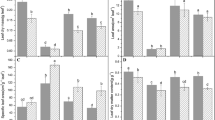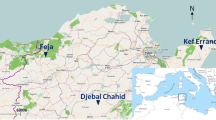Abstract
Intraspecific variability in morphological and ecophysiological leaf traits might be theorized to be present in declining populations, since they seem to be exposed to stress and plasticity could be advantageous. Here we focused on declining Persian oaks (Quercus brantii Lindl. var. persica (Jaub and Spach) Zohary) in the Zagros Mountains of western Iran, representing the most important tree species of this region. We selected trees with contrasting crown dieback, from healthy to severely defoliated, to investigate the relationships between canopy dieback and leaf morphology, water content and pigments. We also measured esterase and peroxidase, as enzymatic antioxidants and indicators of contrasting genotypes. Trees showing moderate to severe defoliation showed higher leaf mass area (LMA), reduced relative water content (RWC), and lower stomatal density (SD). Increasing LMA indicates a more sclerophyllic structure, according to drier conditions. We did not find significant differences in leaf pigments (chlorophyll a and b, and carotenoids) among crown dieback classes, suggesting that Persian oak trees are able to maintain accurate photochemical efficiency, while reduced RWC and SD suggest hydraulic limitations. Our results do not provide a consistent pattern as regards enzymatic antioxidant defense in Persian oak. Morphological leaf traits would be important drivers of future adaptive evolution in Persian oak, leading to smaller and thicker leaves, which have fitness benefits in dry environments. Nonetheless, drought responses may be critically affecting carbon uptake, as photosynthetic compounds are less effectively used in leaves with higher sclerophylly.
Similar content being viewed by others
References
Abrams MD (1990) Adaptations and responses to drought in Quercus species of North America. Tree Physiol 7:227–238
Ackerly D, Dudley S, Sultan SE, Schmitt J, Coleman J, Linder CR, Sandquist DR, Geber MA, Evans AS, Dawson E, Lechowic M (2000) The evolution of plant ecophysiological traits: recent advances and future directions. Bioscience 50:979–995
Allen CD, Macalady AK, Chenchouni H, Bachelet D, McDowell N, Vennetier M, Kitzberger T, Rigling A, Breshears DD, Hogg EH, Gonzalez P, Fensham R, Zhang Z, Castro J, Demidova N, Lim JH, Allard G, Running SW, Semerci A, Cobb N (2010) A global overview of drought and heat-induced tree mortality reveals emerging climate change risks for forests. For Ecol Manag 259(4):660–684
Aranda I, Castro L, Pardos M, Gil L, Pardos JA (2005) Effects of the interaction between drought and shade on water relations, gas exchange and morphological traits in cork oak Quercus suber L. seedlings. For Ecol Manag 210:117–129
Asakereh H (2007) Temporal and spatial variations of precipitation in Iran during the last decades. Iran J Geogr Dev 10:145–164
Atkins KE, Travis JMJ (2010) Local adaptation and the evolution of species’ ranges under climate change. J Theor Biol 266:449–457
Bussotti F (2008) Functional leaf traits, plant communities and acclimation processes in relation to oxidative stress in trees: a critical overview. Glob Change Biol 14(11):2727–2739
Chaves MM, Maroco JP, Pereira JS (2003) Understanding plant responses to drought: from genes to the whole plant. Funct Plant Biol 30:239–264
Chevin LM, Lande R (2010) When do adaptive plasticity and genetic evolution prevent extinction of a density-regulated population? Evolution 64:1143–1150
Corcuera L, Camarero JJ, Gil-Pelegrin E (2002) Functional groups in Quercus species derived from the analysis of pressure–volume curves. Trees 16:465–472
Cornelissen JHC, Lavorel S, Garnier E, Diaz S, Buchmann N, Gurvich DE, Reich PB, ter Steege H, Morgan HD, van der Heijden MGA, Pausas JG, Poorter H (2003) A handbook of protocols for standardised and easy measurement of plant functional traits worldwide. Aust J Bot 51:335–380
Duncan DB (1955) Multiple range and multiple F tests. Biometrics 11:1–42
Ferris R, Taylor G (1994) Stomatal characteristics of native herbs following exposure to elevated CO2. Ann Bot 73:447–453
Fotelli MN, Radoglou KM, Constantinidou HIA (2000) Water stress responses of seedlings of four Mediterranean oak species. Tree Physiol 20:1065–1075
García-Nogales A, Linares JC, Laureano RG, Seco JI, Merino J (2016) Range-wide variation in life-history phenotypes: spatiotemporal plasticity across the latitudinal gradient of the evergreen oak Quercus ilex. J Biogeogr 43(12):2366–2379
Gómez-Aparicio L, Pérez-Ramos IM, Mendoza I, Matías L, Quero JL, Castro J, Zamora R, Marañón T (2008) Oak seedling survival and growth along resource gradients in Mediterranean forests: implications for regeneration in current and future environmental scenarios. Oikos 117:1683–1699
Haavik LJ, Billings SA, Guldin JM, Stephen FM (2015) Emergent insects, pathogens and drought shape changing patterns in oak decline in North America and Europe. For Ecol Manag 354:190–205
Hassanzad-Navroodi I, Zarkami R, Basati M, Mohammadi-Limaei S (2015) Quantitative and qualitative characteristics of Persian oak along altitudinal gradation and gradient (case study: Ilam province, Iran). J For Sci 61(7):297–305
Hemeda HM, Kelin BP (1990) Effects of naturally occurring antioxidants on peroxidase activity of vegetables extracts. Food Sci 55:184–185
Hoffmann AA, Sgrö CM (2011) Climate change and evolutionary adaptation. Nature 470:479–485
Hosseini A, Hosseini SM, Linares JC (2017) Site factors and stand conditions associated with Persian oak decline in Zagros mountain forests. For Syst 26(3):e014
Kabrick JM, Dey DC, Jensen RG, Wallendorf M (2008) The role of environmental factors in oak decline and mortality in the Ozark Highlands. For Ecol Manag 255(5–6):1409–1417
Kruskal WH, Wallis WA (1952) Use of ranks in one-criterion variance analysis. J Am Stat Assoc 47(260):583–621
Laureano RG, Lazo YO, Linares JC, Luque A, Martínez F, Seco J, Merino J (2008) The cost of stress resistance: construction and maintenance costs of leaves and roots in two populations of Quercus ilex. Tree Physiol 28:1721–1728
Laureano RG, García-Nogales A, Seco JI, Linares JC, Martínez F, Merino J (2016) Plant maintenance and environmental stress: summarising the effects of contrasting elevation, soil, and latitude on Quercus ilex respiration rates. Plant Soil 409(1):389–403
Lázaro-Nogal A, Matesanz S, Godoy A, Pérez-Trautman F, Gianoli E, Valladares F (2015) Environmental heterogeneity leads to higher plasticity in dry-edge populations of a semi-arid Chilean shrub: insights into climate change responses. J Ecol 103:338–350
Lichtenthaler HK (1987) Chlorophylls and carotenoids: pigments of photosynthetic biomembranes. Methods Enzymol 148:350–382
Liu X, Ellsworth DS, Tyree MT (1997) Leaf nutrition and photosynthetic performance of sugar maple (Acer saccharum) in stands with contrasting health conditions. Tree Physiol 17:169–178
Maherali H, Caruso CM, Sherrard ME, Latta RG (2010) Adaptive value and costs of physiological plasticity to soil moisture limitation in recombinant inbred lines of Avena barbata. Am Nat 175:211–224
Matesanz S, Gianoli E, Valladares F (2010) Global change and the evolution of phenotypic plasticity in plants. Ann N Y Acad Sci 2:35–55
McDowell N, Pockman WT, Allen CD, Breshears DD, Cobb N, Kolb T, Plaut J, Sperry J, West A, Williams DG, Yepez EA (2008) Mechanisms of plant survival and mortality during drought: why do some plants survive while others succumb to drought? New Phytol 178:719–739
Mészáros I, Veres S, Kanalas P, Oláh V, Szöllösi E, Sárvázi E, Lévai L, Lakatos G (2007) Leaf growth and photosynthetic performance of two co-existing oak species in contrasting growing seasons. Acta Silv Lignaria Hung 3:7–20
Munné-Bosch S, Alegre L (2000) Changes in carotenoids, tocopherols and diterpenes during drought and recovery, and the biological significance of chlorophyll loss in Rosmarinus officinalis plants. Planta 207:925–931
Munné-Bosch S, Peñuelas J (2003) Photo- and antioxidative protection during summer leaf senescence in Pistacia lentiscus L. grown under Mediterranean field conditions. Ann Bot 92:385–391
Niinemets Ü (1999) Components of leaf dry mass per area–thickness and density–alter leaf photosynthetic capacity in reverse directions in woody plants. New Phytol 144:35–47
Niinemets Ü (2001) Global-scale climatic controls of leaf dry mass per area, density, and thickness in trees and shrubs. Ecology 82:453–469
Niinemets Ü (2010) Responses of forest trees to single and multiple environmental stresses from seedlings to mature plants: past stress history, stress interactions, tolerance and acclimation. For Ecol Manag 260:1623–1639
Niinemets Ü (2015) Is there a species spectrum within the world-wide leaf economics spectrum? Major variations in leaf functional traits in the Mediterranean sclerophyll Quercus ilex. New Phytol 205:79–96
Niinemets Ü, Keenan T (2014) Photosynthetic responses to stress in Mediterranean evergreens: mechanisms and models. Environ Exp Bot 103:24–41
Ogaya R, Penuelas J (2006) Contrasting foliar responses to drought in Quercus ilex and Phillyrea latifolia. Biol Plant 50:373–382
Ozkur O, Ozdemir F, Bor M, Turkan I (2009) Physiochemical and antioxidant responses of the perennial xerophyte Capparis ovata Desf to drought. Environ Exp Bot 66:487–492
Pigliucci M (2005) Evolution of phenotypic plasticity: where are we going now? Trends Ecol Evol 20:481–486
Poorter H, Niinemets Ü, Poorter L, Wright IJ, Villar R (2009) Causes and consequences of variation in leaf mass per area (LMA): a meta-analysis. New Phytol 182:565–588
Quero JL, Villar R, Marañón T, Zamora R (2006) Interactions of drought and shade effects on seedlings of four Quercus species: physiological and structural leaf responses. New Phytol 170:819–834
Ramírez-Valiente JA, Valladares F, Delgado-Huertas A, Granados S, Aranda I (2010) Factors affecting cork oak growth under dry conditions: local adaptation and contrasting additive genetic variance within populations. Tree Genet Genomes 7:285–295
Reich PB, Ellsworth DS, Walters MB, Vose JM, Gresham C, Volin JC, Bowman WD (1999) Generality of leaf trait relationships: a test across six biomes. Ecology 80:1955–1969
Sardans J, Penuelas J, Ogaya R (2008) Drought-induced changes in C and N stoichiometry in a Quercus ilex Mediterranean forest. For Sci 54:513–522
Smirnoff N (1993) The role of active oxygen in the response of plants to water deficit and desiccation. New Phytol 125:27–58
Smith S, Weyers JDB, Berry WG (1989) Variation in stomatal characteristics over the lower surface of Commelina communis leaves. Plant Cell Environ 12:653–659
Sperlich D, Chang CT, Penuelas J, Gracia C, Sabate S (2015) Seasonal variability of foliar photosynthetic and morphological traits and drought impacts in a Mediterranean mixed forest. Tree Physiol 35(5):501–520
Valladares F, Matesanz S, Guilhaumon F, Araujo MB, Balaguer L, Garzón M, Cornwell W, Gianoli E, van Kleunen M, Naya DE, Nicotra AB, Poorter H, Zavala MA (2014) The effects of phenotypic plasticity and local adaptation on forecasts of species range shifts under climate change. Ecol Lett 17:1351–1364
Villar R, Merino J (2001) Comparison of leaf construction costs in woody species with differing leaf life-spans in contrasting ecosystems. New Phytol 151:213–226
Villar R, Ruiz-Robleto J, Ubera JL, Poorter H (2013) Exploring variation in leaf mass per area (LMA) from leaf to cell: an anatomical analysis of 26 woody species. Am J Bot 100:1969–1980
Wright IJ, Cannon K (2001) Relationships between leaf lifespan and structural defences in a low-nutrient, sclerophyll flora. Funct Ecol 15:351–359
Wright IJ, Westoby M, Reich PB (2002) Convergence towards higher leaf mass per area in dry and nutrient-poor habitats has different consequences for leaf lifespan. J Ecol 90:534–543
Wright IJ, Reich PB, Westoby M, Ackerly DD, Baruch Z, Bongers F, Cavender-Bares J, Chapin T, Cornelissen JHC, Diemer M, Flexas J, Garnier E, Groom PK, Gulias J, Hikosaka K, Lamont BB, Lee T, Lee W, Lusk C, Midgley JJ, Navas ML, Niinemets U, Oleksyn J, Osada N, Poorter H, Poot P, Prior L, Pyankov VI, Roumet C, Thomas SC, Tjoelker MG, Veneklaas EJ, Villar R (2004) The worldwide leaf economics spectrum. Nature 428:821–827
Yannis RY, Kalliopi R (2002) Physiological responses of beech and sessile oak in a natural mixed stand during a dry summer. Ann Bot 89:723–730
Author information
Authors and Affiliations
Corresponding author
Additional information
Project funding: Ministerio de Economía y Competitividad, Spain (CGL2013-48843-C2-2-R); European Union FEDER 0087 (TRANSHABITAT); Tarbiat Modares University (Doctorate support to AH).
The online version is available at http://www.springerlink.com
Corresponding editor: Hu Yanbo.
Electronic supplementary material
Below is the link to the electronic supplementary material.
Rights and permissions
About this article
Cite this article
Hosseini, A., Hosseini, S.M. & Linares, J.C. Linking morphological and ecophysiological leaf traits to canopy dieback in Persian oak trees from central Zagros. J. For. Res. 30, 1755–1764 (2019). https://doi.org/10.1007/s11676-018-0805-4
Received:
Accepted:
Published:
Issue Date:
DOI: https://doi.org/10.1007/s11676-018-0805-4







